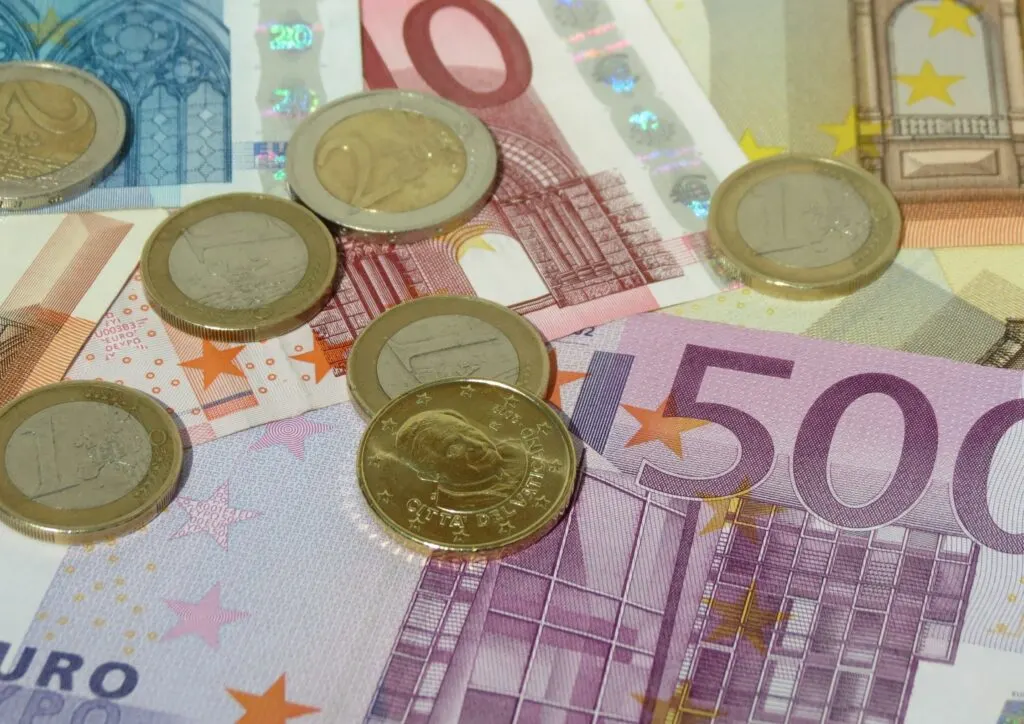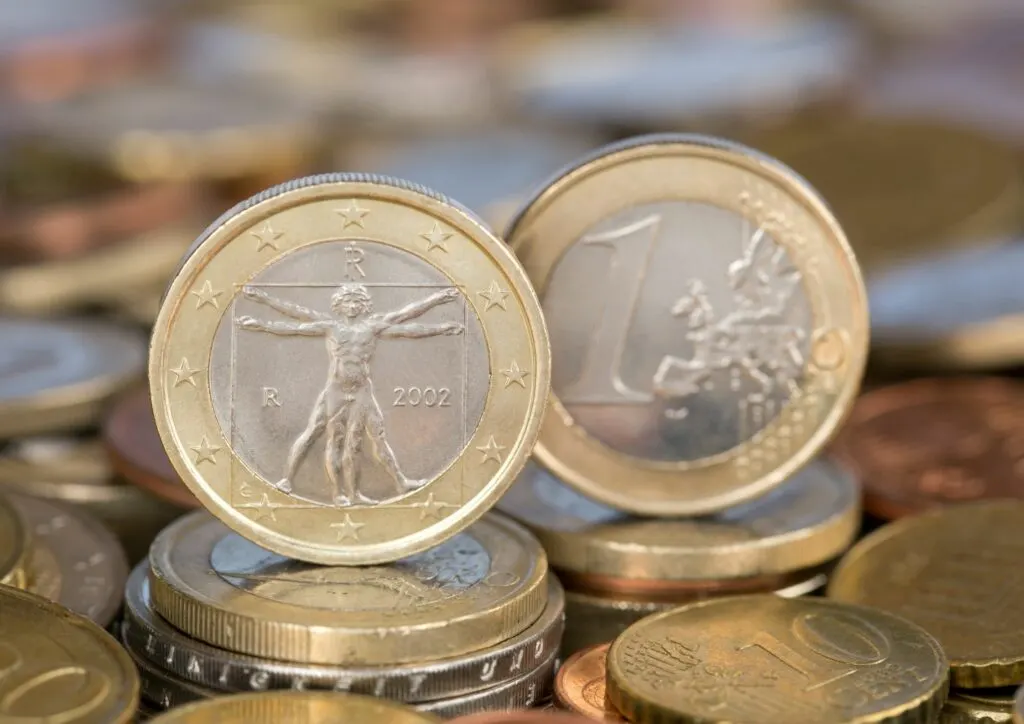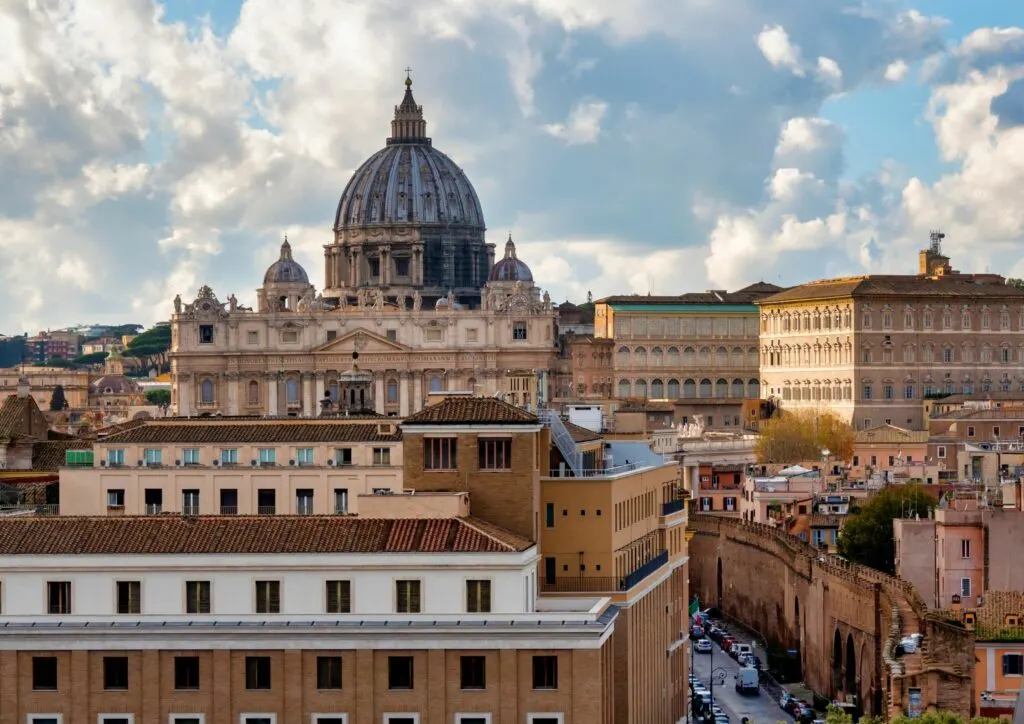Italy uses the Euro like most other European Union countries. The code of the euro is EUR, while the sign is €. Euro comes second on the list of most traded currencies, and it’s issued by the European Central Bank.
Here’s everything you need to know about the usage of Euros in Italy.
Click here to check out some amazing places to visit in Italy!
Which Currency Did Italy Use Before The Euro?
Until February 2002, Italy used a different currency called the lira. However, it stopped being the official currency on 1st January 1999, but it remained legal tender until 2002 – the currency was still in use in 2011, though rarely.
You can’t use the lira in Italy now; the Euro is the official currency in all Italian regions.
What Does The Italian Euro Look Like?

It’s quite easy to tell euro notes apart. They come in different colours and sizes. The design of the notes is meant to make it easier for visually impaired individuals – as opposed to coins, notes are easily distinguished. Every note in Italy bears symbols of Italian culture and history.
In Italy, you’ll find 5,10, 20, 50, 100, 200, and 500 Euro notes; however, 200 and 500 notes are rarely used.
The notes of smaller value are in everyday use, while high-value notes like 100, 200, and 500 are rarely used.
Tips for travellers: Italy is a safe place to travel, but there are pickpockets, so it wouldn’t be wise to carry high-value notes with you.
Also, shops in Italy usually don’t have change for high denomination notes, so when you exchange currency, ask the bank for smaller value notes.
The Italian Euro Coin

Each Italian euro coin carries a symbol of Italian culture and history. You can find 1 and 2 coins, and cents come in denominations of 1,2,5,10,20, and 50.
Tips for travellers: Italian euro coins are small, and they all look pretty much the same, so you need to be careful when you pay for things with coins.
Also, try to use up all your coins before leaving Italy as it’s hard to exchange them – although you could keep them as mementoes of your travels.
Can I Use The Euro In Vatican City?

Vatican City isn’t a member of the European Union and is separate from Italy, but the state uses the Euro. Like in Italy, in Vatican City too, the Lira was the official currency until it was replaced by the Euro in 2002.
Euro coins from every European region are accepted here, but the city has its own coins styled distinctly. On the front of the Vatican Euro coins bear the coat of arms, and on the back, you can see either the image of a Pope or the coat of arms.
Tips for travellers: These coins aren’t issued in great numbers, so if you come by any of them, you should keep them as memorabilia of your time in Vatican City. Some shops even sell collectors’ editions.
You might also be interested in: Can you use Uber in Italy?
Adoption of Euro
The European Union introduced the Euro as the common currency between member countries as a way of creating economic equilibrium.
Italy had several reasons for adopting the Euro – encouraging investment, promoting trade, and securing support from other member countries are a few reasons.
Can You Use US Dollars In Italy?
No, the US dollar isn’t accepted in Italy – like how the Euro isn’t accepted in the United States. There might be an odd hotel or vendor that accepts US dollars, but you shouldn’t count on it.
Card Payments In Italy

You can use your debit or credit card to pay for things at most places. Hotels and restaurants usually accept card payments. As for withdrawing money, you can find ATMs everywhere in Italy, even in small cities.
Keep in mind that your bank will charge you a fee for withdrawing money in a foreign country, so withdraw all the money you need for the day at once.
Also, remember that most ATMs in Italy won’t allow you to withdraw more than €250 per day.
What’s The Best Way of Getting Italian Currency?
The best way of getting Italian currency is through ATMs in Italy. But if you don’t want to wait until you reach Italy to buy the currency, buy a small number of Euros from a bank in your home country.
The Euro selling rate at airports is a bit too high, so don’t wait until you reach the airport.
Tips for travellers: when buying Euros, don’t buy more than the amount you need. Remember, if you are carrying a lot of cash, you are susceptible to theft; also, if you buy too much, you’ll have a lot of leftover currency at the end of your trip, so buy exactly the amount of currency you need.
How Much Currency Do I Need For My Travels?
The amount of currency you can bring into Italy is unlimited; however, if you are planning to bring more than 10,000 euros with you, you need to make a declaration.
The amount of cash you need depends on the type of vacation you are taking, but 200 Euros should be sufficient for a week in Italy.
Travellers’ Cheques
Travellers’ cheques are no longer of any use to anyone. You can bring travellers’ cheques, but it’s going to be extremely difficult for you to exchange them at banks, so they are best avoided.
What Can I Do With Unused Cash?
If you have some leftover Euros, you can shop at duty-free shops or exchange them at your local bank. You could also save them for your next trip! Another idea is to keep them as souvenirs – that is, if the leftover currency amount is small.
Tips For Saving Money When Travelling In Italy
Here’s a list of things you can do to save money when touring Italy:
- Travel during the low season, which spans from mid-November to mid-March.
- Look out for hotel deals and packages with discounts – opt for bundle deals with excursions, sightseeing, and complimentary meals.
- Use public transport whenever possible!
- If it’s a long stay, choose an apartment instead of a hotel – apartments are much cheaper and offer better privacy.
- Cook your own meals – you can do this if you are staying at an apartment.
- Buy the things you need from supermarkets or farmer’s markets – markets sell a variety of wines and homemade cheeses at reasonable prices.
- As odd as it sounds, don’t sit down to have your coffee; Italian cafes charge extra for sitting down to have coffee, so have your coffee standing, like locals!
- Buy travel insurance that covers the loss of luggage and medical expenses.
- Seek out free things to do – lots of sightseeing can be done for free.

